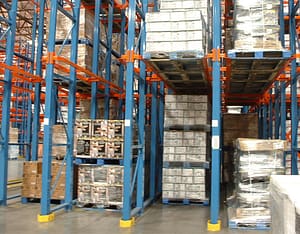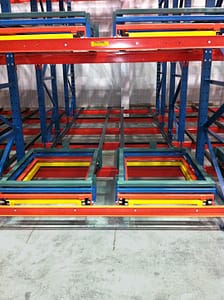If you’re in charge of a plant, you know the importance of keeping everything running smoothly to maintain your production schedule and minimize downtime. Unplanned downtime leads to lost revenue and should be avoided at all costs.
Selecting the right pallet-racking system can make a big difference in your bottom line, especially when labor is scarce and the price of warehouse space continues to increase.
Warehouse pallet racking is the foundation of an entire facility, but before analyzing any particular pallet-racking system, it’s important to consider factors such as:
- Total floor space: This includes the total area of the floor as well as the height of the ceiling. Adding vertical storage will also increase the load on the floor, so make sure the floor can stand up to the added capacity.
- Warehouse layout: This will allow you to plan the orientation of the rack and aisles, as well as the space needed between racks and other obstructions like light fixtures, doors, and fire sprinkler systems.
- Regulations: Take into account any federal, state, and local regulations for warehouses in your area because they may affect the types of materials you’re allowed to use and what system will work best in your warehouse.
- Forklift access: Different pallet-racking systems allow for different sizes of lift trucks and varying levels. The taller the rack systems go, the more sophisticated the forklifts have to get. The common types of forklift masts are:
- Single-stage: has only one channel and therefore a limited lifting height
- Two-stage: typically used for stacking and double stacking for indoor applications with limited overhead clearance
- Three-stage: its free lift and greater heights make for great lift for stacking in general warehouse applications
- Quad: designed for very high stacking in specialized warehousing and other industries
Why Warehouse Pallet Racking?
Making the most of your space is essential. Pallet-racking systems improve the efficiency of warehouse operations by enabling more effective use of available space. Pallet racking helps plant managers make better use of vertical space because they can safely store materials on high shelves without risk.
Pallet racking also makes warehouses clean and tidy, which improves efficiency and helps to prevent misplaced items. Furthermore, consistent use of warehouse pallet racks for storage increases pick and put-away time and improves the flexibility of existing space.
Types of Pallet-Racking Systems
There are many types of warehouse pallet-racking systems available, each one designed for different applications and facility types—some offer dense storage capacity while others offer easier access to stored loads. Some of the most common systems include selective, drive-in, push-back, pallet flow, and double-deep.
Selective

Selective pallet racking is the most popular and versatile system in the industry and maintains the lowest upfront cost per pallet position compared to other systems. Additionally, ease of adjustability, full selectivity, and direct access to a diverse stock-keeping unit (SKU) count provides ease of scalability, especially as the market grows and more pallet racking is required.
Drive-In
 For cost-effective, high-density storage, drive-in pallet racking is often the best choice. Requiring fewer aisles and providing better space utilization than standard selective pallet racks, drive-in racking allows you to store up to 75 percent more pallets. Drive-in pallet racking allows forklifts to drive directly into the rack to allow storage of two or more pallets deep.
For cost-effective, high-density storage, drive-in pallet racking is often the best choice. Requiring fewer aisles and providing better space utilization than standard selective pallet racks, drive-in racking allows you to store up to 75 percent more pallets. Drive-in pallet racking allows forklifts to drive directly into the rack to allow storage of two or more pallets deep.
Push-Back
 Push-back pallet racking is an alternative method that is nearly identical to drive-in and continuing to grow in popularity. This system can go two to six pallets deep and uses the first in, last out product flow system in any given lane. Push-back pallet racks tend to give building owners/operators more flexibility than other systems.
Push-back pallet racking is an alternative method that is nearly identical to drive-in and continuing to grow in popularity. This system can go two to six pallets deep and uses the first in, last out product flow system in any given lane. Push-back pallet racks tend to give building owners/operators more flexibility than other systems.
Pallet Flow
 Commonly used for storing a large number of pallets of the same product or SKU, pallet flow racks provide a space-saving, high-density solution to your storage needs. Utilizing the first in, first out methodology, these racks get inventory moving—pallets are loaded from one side and picked from the other while the rest of the work is done by durable, high-performance wheels. This has the potential to save both time and labor.
Commonly used for storing a large number of pallets of the same product or SKU, pallet flow racks provide a space-saving, high-density solution to your storage needs. Utilizing the first in, first out methodology, these racks get inventory moving—pallets are loaded from one side and picked from the other while the rest of the work is done by durable, high-performance wheels. This has the potential to save both time and labor.
Double-Deep
 Double-deep pallet-racking systems use 11-foot aisles but include a double-deep access system. This is achieved by placing two sections of pallet rack back-to-back, effectively increasing storage capacity while maintaining one access aisle.
Double-deep pallet-racking systems use 11-foot aisles but include a double-deep access system. This is achieved by placing two sections of pallet rack back-to-back, effectively increasing storage capacity while maintaining one access aisle.
Ready to Kick Off Your Project?
Pallet racks are the lifeblood of most distribution centers and warehouse facilities. Warehouse pallet-racking systems are most effective when they fit your product and inventory management model and are compatible with your lift equipment.
A properly designed and installed pallet-racking system can increase productivity and maximize storage in your warehouse, especially when expansion isn’t an option. At Conveyer & Caster, we’ve helped our customers make their pallet racks safer and more efficient.
If you have any additional questions about types of pallet racks, pallet-racking installation, or how the right pallet racking can improve your bottom line, please contact us. Our pallet racks help maximize your floor space, decrease putaway and retrieval times, and ensure employee safety.









1 comment
As someone deeply invested in optimizing warehouse operations, I found the breakdown of benefits immensely insightful. Something I would like to add is that quality is really important.